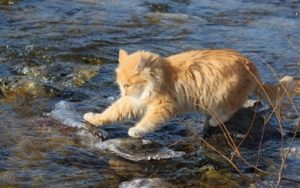Cats and fish have a long-standing relationship, with many cats having a strong affinity for fish as a food source. However, it may come as a surprise that despite their love for fish, most cats are not able to swim. This raises the question: why do cats like to eat fish but can’t swim? In this article, we will explore the reasons behind this phenomenon and delve into the interesting world of cats and their relationship with water.

Why are cats afraid of water?
The fear of water, also known as aquaphobia, is a common trait among cats. This fear can manifest in various ways, such as avoiding bodies of water or panicking when exposed to water. But why are cats afraid of water? There are several theories as to why cats have an aversion to water.
Evolutionary reasons
One theory suggests that cats’ fear of water stems from their evolutionary history. Cats are descendants of desert-dwelling animals, and their ancestors did not have much exposure to water. As a result, they did not develop the ability to swim and were not accustomed to being in water. This lack of familiarity with water could explain why most cats are afraid of it.
Negative experiences
Another possible reason for cats’ fear of water could be due to negative experiences. If a cat has had a traumatic experience involving water, such as falling into a pool or being sprayed with water, it could develop a fear of water. This fear can then be passed down through generations, as cats learn from their mothers and other cats in their environment.
Sensitive fur
Cats are known for their fastidious grooming habits, and their fur plays a crucial role in keeping them clean. Their fur is designed to repel water, making it difficult for them to get wet. When cats’ fur gets wet, it becomes heavy and can weigh them down, making it challenging for them to move. This could be another reason why cats are afraid of water.
Can cats swim?

Despite their fear of water, some cats are actually good swimmers. However, not all cats possess this ability, and it largely depends on their breed and individual personality. Some breeds, such as the Turkish Van and Bengal cats, have a natural affinity for water and enjoy swimming. These cats have been known to jump into pools or ponds without hesitation.
On the other hand, most domestic cats are not able to swim due to their lack of exposure to water and their physical limitations. Cats’ bodies are not designed for swimming, with their short legs and small paws making it difficult for them to paddle effectively. Additionally, their fur is not waterproof, which can make it challenging for them to stay afloat.
Characteristics of cat breeds that can swim well
As mentioned earlier, some cat breeds have a natural inclination towards water and are excellent swimmers. These breeds possess certain characteristics that make them more adept at swimming than others.
Large body size
Cats that are larger in size tend to be better swimmers. This is because they have a higher body mass, which helps them stay afloat in water. Breeds like the Maine Coon and Norwegian Forest Cat, known for their large size, are also known to be good swimmers.
Water-resistant coat
Certain cat breeds have coats that are more water-resistant than others. This makes it easier for them to swim without getting weighed down by wet fur. Breeds like the Turkish Van and Bengal cats have coats that are naturally water-repellent, making them excellent swimmers.
Why do cats love to eat fish?

Now that we’ve explored the reasons behind cats’ fear of water, let’s delve into the question of why cats love to eat fish. The answer lies in their evolutionary history and their natural instincts.
Cats are obligate carnivores, meaning they need to consume meat to survive. In the wild, cats would hunt for small animals like rodents, birds, and fish. Fish is a rich source of protein and essential nutrients that cats need to maintain a healthy diet. Therefore, it is only natural for cats to have a strong desire for fish as a food source.
The most nutritious part of a fish for cats
When it comes to feeding your cat fish, it’s essential to know which parts are the most nutritious. While cats may enjoy eating the whole fish, certain parts are more beneficial for their health.
The flesh
The flesh of a fish is the most commonly consumed part by cats. It is high in protein and contains essential amino acids that are crucial for maintaining muscle mass and overall health. However, it’s important to note that some fish species may contain bones that can be harmful to cats if ingested.
The liver
The liver is another highly nutritious part of a fish for cats. It is rich in vitamins A and D, as well as omega-3 fatty acids, which are essential for maintaining healthy skin and coat. However, it’s important to feed liver in moderation, as too much can lead to vitamin A toxicity.
The head
While it may not be the most appetizing part for humans, the head of a fish is packed with nutrients that are beneficial for cats. It contains high levels of calcium, phosphorus, and magnesium, which are essential for maintaining strong bones and teeth.
Precautions when feeding fish to cats

While fish can be a nutritious addition to your cat’s diet, there are some precautions you should take when feeding it to them.
Avoid raw fish
Raw fish can contain bacteria and parasites that can be harmful to cats. It’s best to cook fish thoroughly before feeding it to your cat to eliminate any potential risks.
Remove bones
As mentioned earlier, some fish species may contain small bones that can be hazardous to cats if ingested. Be sure to remove all bones before feeding fish to your cat to avoid any choking or digestive issues.
Feed in moderation
While fish is a nutritious food for cats, it should not make up the majority of their diet. Cats need a balanced diet that includes other sources of protein and essential nutrients. Too much fish can also lead to an imbalance in certain vitamins and minerals, causing health issues.
Conclusion
In conclusion, cats’ love for fish and their fear of water can be attributed to their evolutionary history and natural instincts. While some breeds may have a natural affinity for water and enjoy swimming, most domestic cats are not able to swim due to their physical limitations and lack of exposure to water. When it comes to feeding fish to cats, it’s important to take precautions and feed in moderation to ensure their overall health and well-being. So next time you see your cat eagerly eyeing a fish, you’ll know why they can’t resist their natural urge to hunt and eat it.